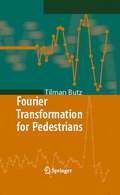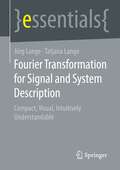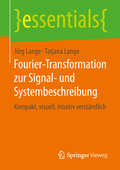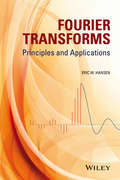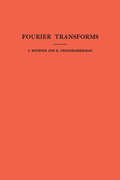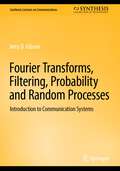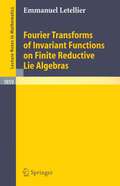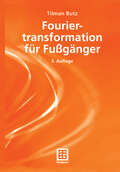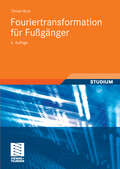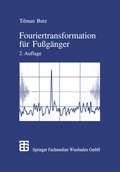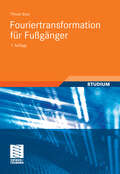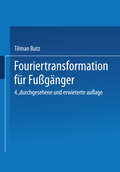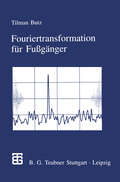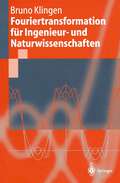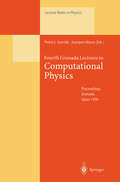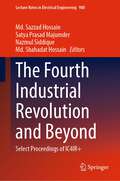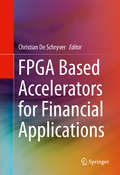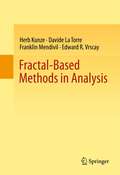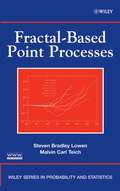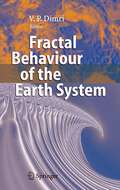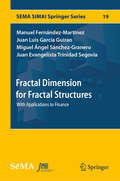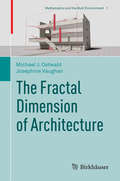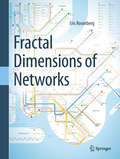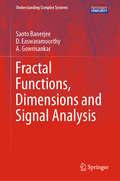- Table View
- List View
Fourier Transformation for Pedestrians
by Tilman ButzCovers Fourier transformation and Fourier series with a particular emphasis on window functions. Written for students and practitioners who deal with Fourier transformation. Including many illustrations and easy-to-solve exercises Presents serious science in an amusing way
Fourier Transformation for Signal and System Description: Compact, Visual, Intuitively Understandable (essentials)
by Jörg Lange Tatjana LangeThe authors explain the Fourier transform and its technical applications, especially in signal and system theory. Based on their many years of teaching experience, they aim at helping especially STEM (science, technology, engineering, and mathematics) students as well as graduated professionals to better understand the subject. The authors also point out the importance of a deeper understanding, as all modern digital technologies such as sound and image recording and storage, radio and television, mobile telephony, signal transmission for the Internet, modern control techniques for vehicles or aircrafts – are largely based on the Fourier transform. The Authors Prof. Dr.-Ing. habil. Jörg Lange held a leading position in the development area of mobile communications in a large technology company. Prof. Dr.-Ing. Tatjana Lange taught control systems engineering at Merseburg University of Applied Sciences and is still active in research in the area of classification and cluster analysis.This Springer essential is a translation of the original German 1st edition essentials, Fourier-Transformation zur Signal- und Systembeschreibung by Jörg Lange and Tatjana Lange, published by Springer Fachmedien Wiesbaden GmbH, part of Springer Nature in 2019. The translation was done with the help of artificial intelligence (machine translation by the service DeepL.com). A subsequent human revision was done primarily in terms of content, so that the book will read stylistically differently from a conventional translation. Springer Nature works continuously to further the development of tools for the production of books and on the related technologies to support the authors.
Fourier-Transformation zur Signal- und Systembeschreibung: Kompakt, visuell, intuitiv verständlich (essentials)
by Jörg Lange Tatjana LangeDie Autoren erläutern die Fourier-Transformation und ihre technischen Anwendungen, insbesondere in der Signal- und Systemtheorie, dank ihrer langjährigen Erfahrungen sehr anschaulich. Sie möchten insbesondere MINT-Studenten und natürlich auch im Beruf stehenden Absolventen helfen, die Materie besser zu verstehen. Die Autoren zeigen zudem die Wichtigkeit eines vertieften Verständnisses auf, da alle modernen digitalen Techniken – wie Ton- und Bildaufzeichnung und Speicherung, Rundfunk und Fernsehen, Mobilfunk, Signalübertragung für das Internet, moderne Regelungstechniken für Fahrzeuge oder Flugzeuge – weitgehend auf den Erkenntnissen der Fourier-Transformation basieren.Die AutorenProf. Dr.-Ing. habil. Jörg Lange war in leitender Position im Entwicklungsbereich Mobilfunk in einem Technologiekonzern tätig, bevor er in Ruhestand ging.Prof. Dr.-Ing. Tatjana Lange lehrte vor ihrem Ruhestand Automatisierungstechnik an der Hochschule Merseburg und ist weiterhin in der Forschung aktiv.
Fourier Transforms: Principles and Applications
by Eric W. HansenFourier Transforms: Principles and Applications explains transform methods and their applications to electrical systems from circuits, antennas, and signal processors—ably guiding readers from vector space concepts through the Discrete Fourier Transform (DFT), Fourier series, and Fourier transform to other related transform methods. Featuring chapter end summaries of key results, over two hundred examples and four hundred homework problems, and a Solutions Manual this book is perfect for graduate students in signal processing and communications as well as practicing engineers. Class-tested at Dartmouth Provides the same solid background as classic texts in the field, but with an emphasis on digital and other contemporary applications to signal and image processing Modular coverage of material allows for topics to be covered by preference MATLAB files and Solutions Manual available to instructors Over 300 figures, 200 worked examples, and 432 homework problems
Fourier Transforms: Principles and Applications
by Eric W. HansenFourier Transforms: Principles and Applications explains transform methods and their applications to electrical systems from circuits, antennas, and signal processors—ably guiding readers from vector space concepts through the Discrete Fourier Transform (DFT), Fourier series, and Fourier transform to other related transform methods. Featuring chapter end summaries of key results, over two hundred examples and four hundred homework problems, and a Solutions Manual this book is perfect for graduate students in signal processing and communications as well as practicing engineers. Class-tested at Dartmouth Provides the same solid background as classic texts in the field, but with an emphasis on digital and other contemporary applications to signal and image processing Modular coverage of material allows for topics to be covered by preference MATLAB files and Solutions Manual available to instructors Over 300 figures, 200 worked examples, and 432 homework problems
Fourier Transforms. (AM-19), Volume 19
by Salomon Bochner Komaravolu ChandrasekharanThe description for this book, Fourier Transforms. (AM-19), Volume 19, will be forthcoming.
Fourier Transforms, Filtering, Probability and Random Processes: Introduction to Communication Systems (Synthesis Lectures on Communications)
by Jerry D. GibsonThis book provides backgrounds and the mathematical methods necessary to understand the basic transforms in signal processing and linear systems to prepare for in depth study of analog and digital communications systems.This tutorial presentation provides developments of Fourier series and other orthogonal series, including trigonometric and complex exponential Fourier series, least squares approximations and generalized Fourier series, and the spectral content of periodic signals. This text thoroughly covers Fourier transform pairs for continuous time signals, Fourier transform properties, and the magnitude and phase of Fourier transforms. The author includes discussions of techniques for the analysis of continuous time linear systems in the time and frequency domains with particular emphasis on the system transfer function, impulse response, system/filter bandwidth, power and energy calculations, and the time domain sampling theorem.
Fourier Transforms of Invariant Functions on Finite Reductive Lie Algebras (Lecture Notes in Mathematics #1859)
by Emmanuel LetellierThe Fourier transforms of invariant functions on finite reductive Lie algebras are due to T.A. Springer (1976) in connection with the geometry of nilpotent orbits. In this book the author studies Fourier transforms using Deligne-Lusztig induction and the Lie algebra version of Lusztig’s character sheaves theory. He conjectures a commutation formula between Deligne-Lusztig induction and Fourier transforms that he proves in many cases. As an application the computation of the values of the trigonometric sums (on reductive Lie algebras) is shown to reduce to the computation of the generalized Green functions and to the computation of some fourth roots of unity.
Fouriertranformation für Fußgänger
by Tilman ButzDieses Werk ist ein unterhaltsames Lehrbuch. Es wendet sich an alle, die in der Ausbildung und in ihrer beruflichen Praxis mit Fouriertransformationen zu tun haben. Dabei sind elementare Kenntnisse der Integralrechnung wünschenswert. Das Buch behandelt sowohl Fourierreihen als auch kontinuierliche und diskrete Fouriertransformationen. Zahlreiche Abbildungen und Beispiele, die vom Leser meist von Hand nachgerechnet werden können, machen den Stoff leicht verständlich.
Fouriertransformation für Fußgänger
by Tilman ButzDieses unterhaltsame Lehrbuch wendet sich an alle, die in der Ausbildung und in ihrer beruflichen Praxis mit Fouriertransformationen zu tun haben. Das Buch behandelt sowohl Fourierreihen als auch kontinuierliche und diskrete Fouriertransformationen. Außerdem werden Fensterfunktionen ausführlich diskutiert. Zahlreiche Abbildungen und Beispiele, die vom Leser meist von Hand nachgerechnet werden können, machen den Stoff leicht verständlich.
Fouriertransformation für Fußgänger
by Tilman ButzDieses Werk ist ein unterhaltsames Lehrbuch. Es wendet sich an alle, die in der Ausbildung und in ihrer beruflichen Praxis mit Fouriertransformationen zu tun haben: Studenten der Ingenieur- und Naturwissenschaften, aber auch Praktiker, die Spektralanalysen oder Fouriertransformationsmethoden benötigen. Dabei sind elementare Kenntnisse der Integralrechnung wünschenswert. Das Buch behandelt sowohl Fourierreihen als auch kontinuierliche und diskrete Fouriertransformationen. Zahlreiche Abbildungen und Beispiele, die vom Leser meist von Hand nachgerechnet werden können, machen den Stoff leicht verdaulich.
Fouriertransformation für Fußgänger
by Tilman ButzDieses unterhaltsame Lehrbuch wendet sich an alle, die in der Ausbildung und in ihrer beruflichen Praxis mit Fouriertransformationen zu tun haben. Das Buch behandelt sowohl Fourierreihen als auch kontinuierliche und diskrete Fouriertransformationen. Außerdem werden Fensterfunktionen ausführlich diskutiert. Zahlreiche Abbildungen und Beispiele, die vom Leser meist von Hand nachgerechnet werden können, machen den Stoff leicht verständlich.
Fouriertransformation für Fußgänger
by Tilman ButzDiese Schrift ist ein unterhaltsames Lehrbuch. Es wendet sich an alle, die in der Ausbildung und in ihrer beruflichen Praxis mit Fouriertransformationen zu tun haben. Das Buch behandelt sowohl Fourierreihen als auch kontinuierliche und diskrete Fouriertransformationen. Außerdem werden Fensterfunktionen ausführlich diskutiert. Zahlreiche Abbildungen und Beispiele, die vom Leser meist von Hand nachgerechnet werden können, machen den Stoff leicht verständlich. Die vierte Auflage enthält einige Verbesserungen und am Ende der jeweiligen Kapitel zahlreiche neue Aufgaben - genannt "Spielwiese" - mit Lösungen im Anhang.
Fouriertransformation für Ingenieur- und Naturwissenschaften (Springer-Lehrbuch)
by Bruno KlingenDieses Lehrbuch wendet sich an Studenten der Ingenieurfächer und der Naturwissenschaften. Durch seinen systematischen und didaktischen Aufbau vermeidet es ungenaue Formulierungen und legt so die Grundlage für das Verständnis auch neuerer Methoden. Indem die klassische und die Funktionalanalysis auf der Basis des Fourieroperators zusammengeführt werden, vermittelt es ein fundiertes und verantwortbares Umgehen mit der Fouriertransformation. Gleichzeitig bietet dieses Konzept die Möglichkeit, auch die Fourierreihen, die diskrete Fouriertransformation und die Behandlung der diskreten Filter in einem einheitlichen Zusammenhang darzustellen. Das Buch enthält zahlreiche gelöste Übungsaufgaben. NEU ! Online-Ergänzungen zum Buch im Internet: - zum Kennenlernen und Vergleichen der mathematischen Programmiersysteme Mathematica, Matlab, Maple - zur Vertiefung des Buchinhaltes (unter "Extras im Web")
Fourth Granada Lectures in Computational Physics: Proceedings of the 4th Granada Seminar on Computational Physics Held at Granada, Spain, 9–14 September 1996 (Lecture Notes in Physics #493)
by Pedro L. Garrido Joaquin MarroThe methods developed to deal with the computational aspects of physi cal problems are useful in an increasing number of situations, from chem istry, biology and geology to engineering, communications and economics. In fact, computational physics has evolved into a trans-disciplinary field now concerned with the creative use of computers in scientific research. More over, computational methods often help students to develop a deeper under standing of key concepts, and enhance their problem-solving abilities. There fore, computational physics is recognized as having an important educational value, and educators face the task of outlining appropriate curricula to take advantage of these unique features. This is an important motivation for the publication of the contents of the Seminar on Computational Physics which is held in Granada every two years. The seminar aims at bringing together small groups of students and active researchers on different aspects of computational physics. It is part of the doctoral programme of the University of Granada. The proceedings of the previous editions were published as II Granada Lectures in Computational Physics (World Scientific, Singapore 1993) and Third Granada Lectures in Computational Physics (Lecture Notes in Physics, vol. 448, Springer, Berlin 1995) by the same editors. The present book contains the invited lecture notes and a very brief account of contributions by participants at the 4th Granada Seminar on Computational Physics (Granada, Spain, 9-14 September 1996).
The Fourth Industrial Revolution and Beyond: Select Proceedings of IC4IR+ (Lecture Notes in Electrical Engineering #980)
by Md. Sazzad Hossain Satya Prasad Majumder Nazmul Siddique Md. Shahadat HossainThe book constitutes selected peer-reviewed proceedings of the International Conference on the 4th Industrial Revolution and Beyond (IC4IR 2021). It focuses on the research trends, challenges, and future of artificial intelligence (AI). It explores the potential for the integration of advanced AI algorithms. The book addresses the challenges of Data Science for industrial applications in developing and under-developed countries and various security issues. It includes qualitative and quantitative research and provides case studies with working models. The book focuses on artificial intelligence and its applications for industry, innovation, and infrastructure. The book serves as a reference book for practitioners and researchers working in the areas of AI, soft computing, IoT, and data analytics.
FPGA Based Accelerators for Financial Applications
by Christian SchryverThis book covers the latest approaches and results from reconfigurable computing architectures employed in the finance domain. So-called field-programmable gate arrays (FPGAs) have already shown to outperform standard CPU- and GPU-based computing architectures by far, saving up to 99% of energy depending on the compute tasks. Renowned authors from financial mathematics, computer architecture and finance business introduce the readers into today’s challenges in finance IT, illustrate the most advanced approaches and use cases and present currently known methodologies for integrating FPGAs in finance systems together with latest results. The complete algorithm-to-hardware flow is covered holistically, so this book serves as a hands-on guide for IT managers, researchers and quants/programmers who think about integrating FPGAs into their current IT systems.
Fractal-Based Methods in Analysis
by Herb Kunze Davide La Torre Franklin Mendivil Edward R. VrscayThe idea of modeling the behaviour of phenomena at multiple scales has become a useful tool in both pure and applied mathematics. Fractal-based techniques lie at the heart of this area, as fractals are inherently multiscale objects; they very often describe nonlinear phenomena better than traditional mathematical models. In many cases they have been used for solving inverse problems arising in models described by systems of differential equations and dynamical systems. "Fractal-Based Methods in Analysis" draws together, for the first time in book form, methods and results from almost twenty years of research in this topic, including new viewpoints and results in many of the chapters. For each topic the theoretical framework is carefully explained using examples and applications. The second chapter on basic iterated function systems theory is designed to be used as the basis for a course and includes many exercises. This chapter, along with the three background appendices on topological and metric spaces, measure theory, and basic results from set-valued analysis, make the book suitable for self-study or as a source book for a graduate course. The other chapters illustrate many extensions and applications of fractal-based methods to different areas. This book is intended for graduate students and researchers in applied mathematics, engineering and social sciences. Herb Kunze is a professor of mathematics at the University of Guelph in Ontario. Davide La Torre is an associate professor of mathematics in the Department of Economics, Management and Quantitative Methods of the University of Milan. Franklin Mendivil is a professor of mathematics at Acadia University in Nova Scotia. Edward Vrscay is a professor in the department of Applied Mathematics at the University of Waterloo in Ontario. The major focus of their research is on fractals and the applications of fractals.
Fractal-Based Point Processes (Wiley Series in Probability and Statistics #366)
by Steven Bradley Lowen Malvin Carl TeichAn integrated approach to fractals and point processes This publication provides a complete and integrated presentation of the fields of fractals and point processes, from definitions and measures to analysis and estimation. The authors skillfully demonstrate how fractal-based point processes, established as the intersection of these two fields, are tremendously useful for representing and describing a wide variety of diverse phenomena in the physical and biological sciences. Topics range from information-packet arrivals on a computer network to action-potential occurrences in a neural preparation. The authors begin with concrete and key examples of fractals and point processes, followed by an introduction to fractals and chaos. Point processes are defined, and a collection of characterizing measures are presented. With the concepts of fractals and point processes thoroughly explored, the authors move on to integrate the two fields of study. Mathematical formulations for several important fractal-based point-process families are provided, as well as an explanation of how various operations modify such processes. The authors also examine analysis and estimation techniques suitable for these processes. Finally, computer network traffic, an important application used to illustrate the various approaches and models set forth in earlier chapters, is discussed. Throughout the presentation, readers are exposed to a number of important applications that are examined with the aid of a set of point processes drawn from biological signals and computer network traffic. Problems are provided at the end of each chapter allowing readers to put their newfound knowledge into practice, and all solutions are provided in an appendix. An accompanying Web site features links to supplementary materials and tools to assist with data analysis and simulation. With its focus on applications and numerous solved problem sets, this is an excellent graduate-level text for courses in such diverse fields as statistics, physics, engineering, computer science, psychology, and neuroscience.
Fractal Behaviour of the Earth System
by V. P. DimriIt is with pleasure that I write the foreword to this excellent book. A wide range of observations in geology and solid-earth geophysics can be - plained in terms of fractal distributions. In this volume a collection of - pers considers the fractal behavior of the Earth's continental crust. The book begins with an excellent introductory chapter by the editor Dr. V.P. Dimri. Surface gravity anomalies are known to exhibit power-law spectral behavior under a wide range of conditions and scales. This is self-affine fractal behavior. Explanations of this behavior remain controversial. In chapter 2 V.P. Dimri and R.P. Srivastava model this behavior using Voronoi tessellations. Another approach to understanding the structure of the continental crust is to use electromagnetic induction experiments. Again the results often exhibit power law spectral behavior. In chapter 3 K. Bahr uses a fractal based random resister network model to explain the observations. Other examples of power-law spectral observations come from a wide range of well logs using various logging tools. In chapter 4 M. Fedi, D. Fiore, and M. La Manna utilize multifractal models to explain the behavior of well logs from the main KTB borehole in Germany. In chapter 5 V.V. Surkov and H. Tanaka model the electrokinetic currents that may be as- ciated with seismic electric signals using a fractal porous media. In chapter 6 M. Pervukhina, Y. Kuwahara, and H. Ito use fractal n- works to correlate the elastic and electrical properties of porous media.
Fractal Dimension for Fractal Structures: With Applications to Finance (SEMA SIMAI Springer Series #19)
by Manuel Fernández-Martínez Juan Luis García Guirao Miguel Ángel Sánchez-Granero Juan Evangelista Trinidad SegoviaThis book provides a generalised approach to fractal dimension theory from the standpoint of asymmetric topology by employing the concept of a fractal structure. The fractal dimension is the main invariant of a fractal set, and provides useful information regarding the irregularities it presents when examined at a suitable level of detail. New theoretical models for calculating the fractal dimension of any subset with respect to a fractal structure are posed to generalise both the Hausdorff and box-counting dimensions. Some specific results for self-similar sets are also proved. Unlike classical fractal dimensions, these new models can be used with empirical applications of fractal dimension including non-Euclidean contexts. In addition, the book applies these fractal dimensions to explore long-memory in financial markets. In particular, novel results linking both fractal dimension and the Hurst exponent are provided. As such, the book provides a number of algorithms for properly calculating the self-similarity exponent of a wide range of processes, including (fractional) Brownian motion and Lévy stable processes. The algorithms also make it possible to analyse long-memory in real stocks and international indexes.This book is addressed to those researchers interested in fractal geometry, self-similarity patterns, and computational applications involving fractal dimension and Hurst exponent.
The Fractal Dimension of Architecture (Mathematics and the Built Environment #1)
by Michael J. Ostwald Josephine VaughanFractal analysis is a method for measuring, analysing and comparing the formal or geometric properties of complex objects. In this book it is used to investigate eighty-five buildings that have been designed by some of the twentieth-century’s most respected and celebrated architects. Including designs by Le Corbusier, Eileen Gray, Frank Lloyd Wright, Robert Venturi, Frank Gehry, Peter Eisenman, Richard Meier and Kazuyo Sejima amongst others, this book uses mathematics to analyse arguments and theories about some of the world’s most famous designs. Starting with 625 reconstructed architectural plans and elevations, and including more than 200 specially prepared views of famous buildings, this book presents the results of the largest mathematical study ever undertaken into architectural design and the largest single application of fractal analysis presented in any field. The data derived from this study is used to test three overarching hypotheses about social, stylistic and personal trends in design, along with five celebrated arguments about twentieth-century architecture. Through this process the book offers a unique mathematical insight into the history and theory of design.
Fractal Dimensions of Networks (Springerbriefs In Computer Science Ser.)
by Eric RosenbergCurrent interest in fractal dimensions of networks is the result of more than a century of previous research on dimensions. Fractal Dimensions of Networks ties the theory and methods for computing fractal dimensions of networks to the “classic” theory of dimensions of geometric objects.The goal of the book is to provide a unified treatment of fractal dimensions of sets and networks. Since almost all of the major concepts in fractal dimensions originated in the study of sets, the book achieves this goal by first clearly presenting, with an abundance of examples and illustrations, the theory and algorithms for sets, and then showing how the theory and algorithms have been applied to networks. Thus, the book presents the classical theory and algorithms for the box counting dimension for sets, and then presents the box counting dimension for networks. All the major fractal dimensions are studied, e.g., the correlation dimension, the information dimension, the Hausdorff dimension, the multifractal spectrum, as well as many lesser known dimensions. Algorithm descriptions are accompanied by worked examples, many applications of the methods are presented, and many exercises, ranging in difficulty from easy to research level, are included.
Fractal Functions, Dimensions and Signal Analysis (Understanding Complex Systems)
by Santo Banerjee D. Easwaramoorthy A. GowrisankarThis book introduces the fractal interpolation functions (FIFs) in approximation theory to the readers and the concerned researchers in advanced level. FIFs can be used to precisely reconstruct the naturally occurring functions when compared with the classical interpolants. The book focuses on the construction of fractals in metric space through various iterated function systems. It begins by providing the Mathematical background behind the fractal interpolation functions with its graphical representations and then introduces the fractional integral and fractional derivative on fractal functions in various scenarios. Further, the existence of the fractal interpolation function with the countable iterated function system is demonstrated by taking suitable monotone and bounded sequences. It also covers the dimension of fractal functions and investigates the relationship between the fractal dimension and the fractional order of fractal interpolation functions. Moreover, this book explores the idea of fractal interpolation in the reconstruction scheme of illustrative waveforms and discusses the problems of identification of the characterizing parameters. In the application section, this research compendium addresses the signal processing and its Mathematical methodologies. A wavelet-based denoising method for the recovery of electroencephalogram (EEG) signals contaminated by nonstationary noises is presented, and the author investigates the recognition of healthy, epileptic EEG and cardiac ECG signals using multifractal measures. This book is intended for professionals in the field of Mathematics, Physics and Computer Science, helping them broaden their understanding of fractal functions and dimensions, while also providing the illustrative experimental applications for researchers in biomedicine and neuroscience.
